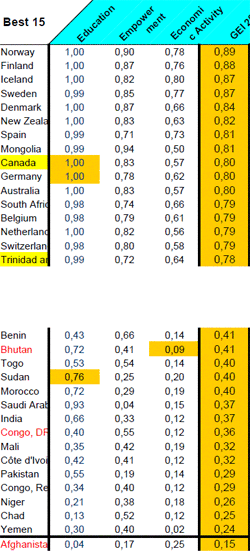Cameroon’s gender equality is below Sub-Saharan average, says watchdog organization
|
Published on Fri, 2012-03-16 10:11
In terms of gender equity Cameroon lags well behind the Sub-Saharan African average, but some of its neighbours and nearby countries are even in a worse condition. This is made apparent by the publication of the Gender Equity Index (GEI) 2012, published by Social Watch on the eve of Women’s International Day, March 8. The GEI prepared annually by Social Watch measures the gap between women and men in education the economy and political empowerment. The index is an average of the inequalities in the three dimensions. In literacy, it examines the gender gap in enrolment at all levels; economic participation computes the gaps in income and employment; empowerment measures the gaps in highly qualified jobs, parliament and senior executive positions.
Social Watch measures the gap between women and men, not their wellbeing. Thus, a country in which young men and women have equal access to the university receives a value of 100 on this particular indicator. In the same fashion, a country in which boys and girls are equally barred from completing primary education would also be awarded a value of 100. This does not mean that the quality of education in both cases is the same. It just establishes that, in both cases girls are not less educated than boys. Cameroon’s 41 points rank it among those countries with VERY LOW GEI. The country’s index seats 11 points below Sub-Saharan Africa’s average --which is 52--, and also behind its neighbours Gabon (61) and Equatorial Guinea (42), and above those of Republic of Congo (29) and Tchad (25), which is also at the lowest level of the world list. It should be noted that Cameroon is remarkably far behind those countries leading the score (as Norway, Finland and Iceland), but also below Sweden, Denmark, New Zealand, Spain and Mongolia, all of them above 80 points, which place them as countries with a MEDIUM GEI. The five levels according to which the index measures the gender gap are: CRITICAL, VERY LOW, LOW, MEDIUM AND ACCEPTABLE, It should be noted that no country has reached 90 points or more, meaning that no country has yet reached the ACCEPTABLE level. Cameroon reaches a LOW level in education (65), a CRITICAL level in empowerment (15) and a VERY LOW level in economic participation (44). South Africa (79), Rwanda (77) and Namibia (77) are the three countries at the top of the Sub-Saharan Africa’s list. The three countries of that region that present largest gaps are the Republic of Congo (29), Niger (26) and Tchad (25). They are also among the five countries in worst condition out of the 154 computed by the IEG 2012, followed by Yemen (24) and Afghanistan (15). Norway, Finland and Iceland are at the top of the world chart, with 89, 88 and 87 points respectively. Social Watch members are spread across all regions. The network fights for the eradication of poverty and its causes, the elimination of all forms of discrimination and racism and to ensure an equitable distribution of wealth and the realization of human rights. For a detailed description of methodology and sources see http://www.socialwatch.org/node/14365 Tags: |


